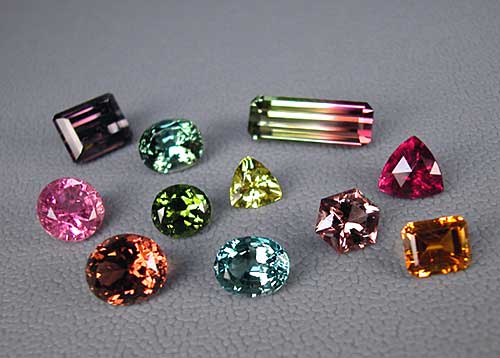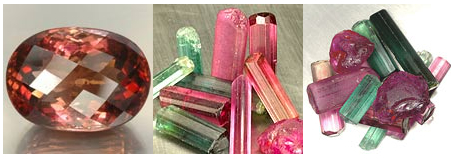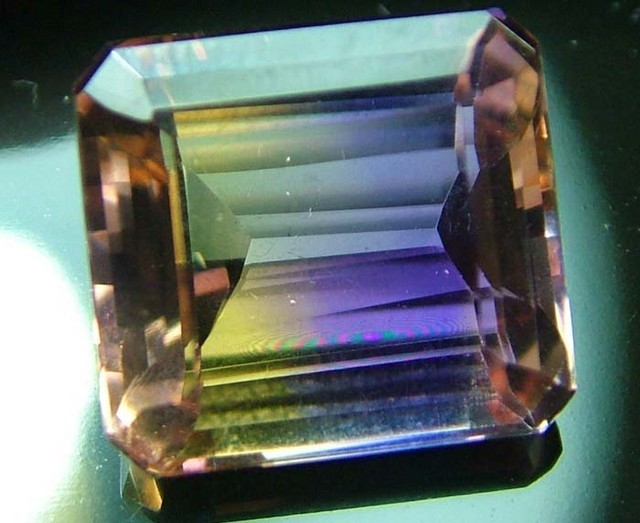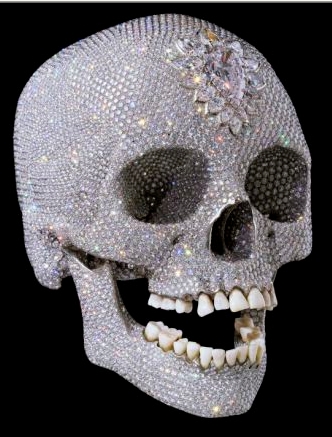Tourmaline’s name comes from the Sinhalese word “turmali,” which means “mixed.” Tourmaline, occurring in more colors and combinations of colors than any other gemstone variety, lives up to its name. The many different colors or Tourmaline mean that this stone can easily be mistaken for just about any other gemstone. Many stones in the Russian Crown jewels from the 17th Century once thought to be rubies are actually Tourmalines.
Introduction
One of the most versatile of gemstones, tourmaline is available in every color, from colorless to black. You can find every tone from pastel to dark, and even with one or more colors appearing in the same stone. It truly is a wondrous and fascinating stone!
Known for centuries, tourmaline first gained popularity when the Dutch began to import it in the early 17th century from Sri Lanka . They gave the gem a Sinhalese name, Turamali, which is believed to mean stone with mixed colors.
Tourmaline is actually the name of a group of related mineral species. In gemological practice, individual species names are not used. Instead, all are simply termed tourmaline. Tourmaline commonly comes from Tanzania, Madagascar, Brazil, Australia, Sri Lanka, the U.S., and Russia, plus other countries.
Color
Color is the major characteristic for tourmaline. This stone is found in more hues, shades and nuances than any other gem. Here are some of the most common varieties that are recognized in the gem trade.
Rubellite – Varying in color from mid to deep reds resembling ruby, rubellite is one of the rarest and most valuable tourmalines. Many gems in the 17th century Russian Crown jewels, originally thought to be rubies, are actually rubellite tourmalines.
Indicolite – From bright blue hues to bluish green colors, indicolite tourmaline is another rare tourmaline color, and high quality specimens are regarded as quite collectable.
Chrome – Chrome tourmaline is green, but is considered different from the regular greens as it derives it rich green color from trace elements of chromium. Found in East Africa , chrome tourmaline is rare and is usually found only in smaller sizes.
Bi-Color – Variations, zones and color bands in tourmaline are often purposefully accented with the cutting style to show bands and color zones in the gem. Occurring in uncountable colors variations, these are often seen in long acicular crystals.
Watermelon – Bi-color tourmalines which show a green skin and a red core; these are sometimes cut as slices
Canary – Bright yellow tourmaline from Malawi .
Paraíba – A rare blue-green tourmaline containing copper, Paraiba tourmaline can be found in amazing bright neon hues and can command thousands of dollars per carat. Found in a single area in Paraiba, Brazil, it is generally found in comparatively small sizes for tourmaline. Recent finds of copper content tourmaline in Nigeria and Mozambique have also produced similar bright neon tourmaline.
Cat’s Eye – Chatoyant tourmaline in a variety of colors. It is often found in a rich green.
Color-Change – Changes from green in daylight to red in incandescent light.
Other varieties may be simply sold with a color prefix, as in pink tourmaline. Like most gems, you want the color to be as intense as possible, however, not too dark or too light.
Tourmaline has strong pleochroism , which means you can see different colors or depths of color when viewed at different angles, such as when you rotate the stone in the light.
Notice the strong pleochroism of this green tourmaline. This is a result of the double refractive characteristic of tourmaline.
Lighting
When viewing tourmaline, reds, oranges and yellows will look best under incandescent light, while greens, blues and violets look their best under daylight.
Carat Weight of Tourmaline and Price
It is common to find tourmaline in large crystal sizes. Large crystal sizes enhance tourmaline’s depth and richness of color.
Like other gems, when the carat weight of a tourmaline increases, so does the price per carat. However, large tourmaline crystals are simply more plentiful than smaller gems such as ruby and sapphire. This means that weight-related price jumps in tourmaline are less severe than in ruby and sapphire. It is common for comparable quality 3 Carat, 4 Carat, and 6 Carat tourmalines to all have similar per carat prices. You will not see this in rubies and sapphires.
Clarity and Inclusion
Different varieties of tourmaline tend to have different clarities. Thus while large clean tourmalines in the blue and blue-green colors are available, almost all red and pink tourmalines will show eye-visible inclusions. The most common inclusions in tourmaline are fractures and liquid-filled healed fractures. Needle inclusions are also common.
Cut
Tourmaline cuts are as varied as its color. With tourmaline’s strong pleochroism, darker tourmalines are cut to display the lighter of the two pleochroic colors. Gems cut with this orientation are often rectangles and rectangular emerald cuts because of the elongated nature of tourmaline crystals.
Tourmalines of lighter color are typically oriented with the table facet perpendicular to the c-axis, to display the richest color possible. Thus, they are often cut as rounds, triangles, trillions and ovals. A quick glance at the tourmaline suite shows this. In addition to faceted stones, cabochon-cut tourmalines often seen on the market.
Treatment and Enhancement
Most tourmaline is untreated. Some tourmaline, such as the rare paraiba variety, is heated to improve the color.
Tourmaline Gemology
- Color: Colorless, pink, brown, red, yellow, green, blue, black, violet, multi-colored
- Moh’s Harness: 7-7½
- Specific Gravity: 2.82-3.32
- Refractive Index: 1.614-1.666
- Double Refraction: -0.014 to -0.032
- Fluorescence: Weak or none
- Cleavage: Indistinct
- Fracture: Uneven, small conchoidal, brittle
- Crystal System: Trigonal. Long crystals with triangular cross section and round sides.
Interesting Fact
An unusual characteristic of this stone is that tourmaline can be electrically charged by heating and cooling, or also applying pressure, such as rubbing the stone. For a long time tourmaline was known in Europe as aschentrekker (ash puller) as the stone was used by the Dutch to pull the ash out of their meerschaum tobacco pipes.
Credit: GemSelect.com
























